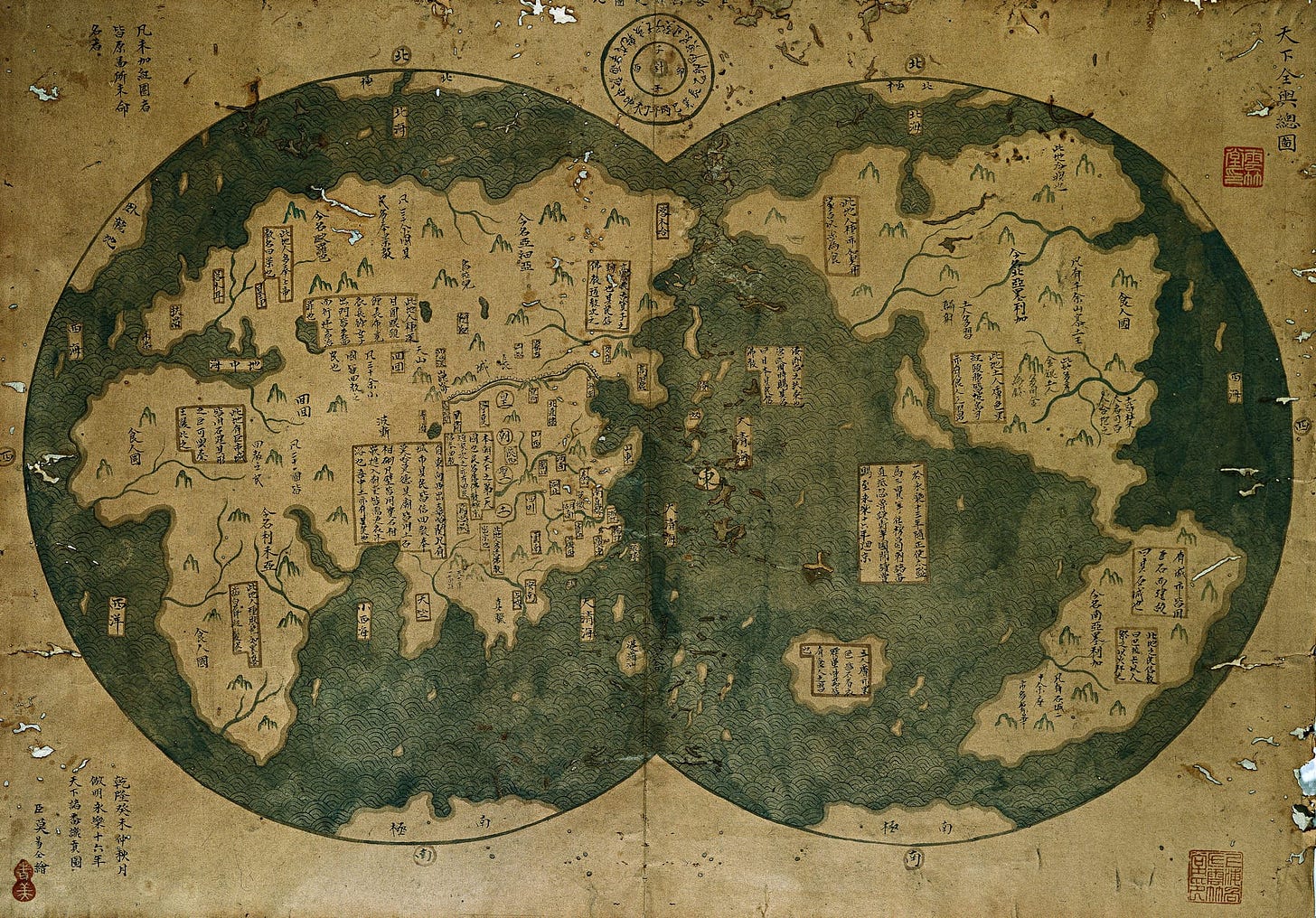1418 world map: Journey through ink and time
Qing-era map suggests the Chinese may have known about the Americas and polar regions long before European explorers

A Qing-era replica of a 1418 world map in a Shanghai bookshop, suggests that Chinese cartographers may have known about the Americas and polar regions long before European explorers.
Using paper analysis, ink aging, wormhole patterns, and historical calligraphy styles, lawyer and art collector, Liu confirmed the map’s 18th-century origins, while its content hinted at even older geographic knowledge.
As a gesture of cultural preservation and intellectual healing, Liu donated the map to the National Library of China, encouraging future research and challenging accepted narratives of global exploration.
By Liu Gang
IN THE spring of 2001, I travelled to Shanghai on a business trip. Before returning home to Beijing, I allowed myself a small indulgence — an afternoon stroll through the antique shops of Dongtai Road. This narrow alley in the heart of Shanghai is famed for its open-air markets offering an eclectic mix of antiques, many of them cleverly forged. Still, I’ve always found something oddly therapeutic in sifting through the clutter — where charm often mingles with authenticity. In a quiet corner of the market sits an easily overlooked bookstore no larger than six square meters.
Run by an elderly man named Mr Xiang, the space overflows with second-hand books, faded newspapers, and dusty ephemera. His family has been in the rare book trade for generations. Over the years, I struck up a warm rapport with Xiang and his son, both of whom share my fascination with old books and historical artifacts. Each time I visited Shanghai, I made a point to stop by, hoping to unearth something rare.
Attracted by an old map
On that particular afternoon, I saw Xiang carefully preparing to tape a large, timeworn map onto the shop’s front wall. Its paper was brittle, the colours faded — but the content made my breath catch. It unmistakably depicted the world’s continents and oceans, including Antarctica, the Arctic, and Greenland. A small inscription in one corner indicated that this was a 1763 replica by Mo Yitong of a much older map dated 1418. What truly caught my eye were red circles marking certain annotations. A note in the upper-left clarified that these red-marked elements had been faithfully copied from the original 1418 version, while the unmarked ones were Mo’s additions. The implications were staggering. Could Chinese cartographers have known of the Americas and polar regions decades before Columbus? Was this an elaborate hoax or a long-buried testimony to early Chinese exploration?
Authenticating ancient works
Before jumping to conclusions, I undertook a careful evaluation using traditional Chinese methods of authenticating ancient works. First, the paper: it was fragile, discoloured, and released a strong musty odour — a telltale sign of age. Much like old houses, ancient paper carries an unshakable scent, difficult for even the most skilled forgers to reproduce.
** SALUTING THE LEGEND. Click here to read our editorial and links to the main stories of the NAC Focus on Zheng He
Next, I studied the wormholes dotting the map. A prominent vertical crease, likely from long-term folding, was surrounded by clustered holes. These mirrored each other on both sides of the fold, suggesting natural development over time, in an enclosed environment with little light. Under magnification, their irregular, rough edges further ruled out artificial puncturing.
The ink told another story. The red circles were made with vermillion ink, commonly used in the Qing Dynasty (1644–1911). Though vermillion remains available today, centuries of oxidation subtly shift its hue. On this map, three modern seals in fresh vermillion stood out sharply against the aged ink — a clear visual contrast. Similarly, the green ocean outlines had faded unevenly, especially along the crease, consistent with natural weathering over centuries.

I then turned to stylistic analysis. Ancient Chinese writing and painting practices differ markedly from today’s. Modern Chinese begins from left to right; older traditions begin at the top right. Telltale signs — such as the fading of initial brushstrokes — showed that this map had been painted in the traditional sequence.
Qing calligraphy
Calligraphy, too, revealed much. Just as clothing trends evolve, so do scripts. During the 17th and 18th centuries, a stiff, formal writing style was required of imperial examination candidates. This distinctive script, used in official documents and artworks, appears throughout the map — neat, rigid, and unmistakably Qing. After carefully examining the paper, ink, wormholes, and script, I concluded that this replica map was genuinely produced in 1763. But its content raised more profound questions: how could anyone in 1418 have had such an advanced grasp of global geography?
Captivated, I purchased the map and launched a personal investigation into its origins. Over time, the map evolved from a collector’s curiosity into a companion in my intellectual journey. Its presence sparked countless late-night conversations and research deep dives. It taught me that history is not static; it is a living tapestry of narratives — some celebrated, others forgotten.
Donating to National Library
Now, as I approach the age of 70, I have decided to donate this rare map to the National Library of China. I believe it is the most fitting home for an artifact of such mystery and magnitude. With its long legacy, world-class conservation facilities, and scholarly community, the Library offers the ideal setting for preserving and studying cultural treasures like this. But beyond its historical value, this donation carries a deeper meaning for me. It is an act of healing — a restoration of dignity to forgotten knowledge, and a quiet rebellion against historical erasure. By placing the map in the hands of future scholars, I hope to rekindle inquiry, inspire debate, and open minds to alternative stories of global exploration. Importantly, the National Library welcomes both researchers and the general public.
In this way, the map can fulfil its full potential — not merely as a relic behind glass, but as a catalyst for dialogue, discovery, and perhaps even the rewriting of what we think we know about our shared human past. This gesture is not just about cultural preservation. It is, at its heart, a personal offering — a tribute to the power of curiosity, the beauty of serendipity, and the quiet, enduring healing that comes from sharing knowledge.
Mr Liu Gang is an avid art collector and a prominent lawyer in Beijing.
Click here to view the programme for the conference on Voyages@Frontiers of New Asia of the Commonwealth of World Chinatowns (CWC), Sept 3-8, 2025, Jen Hotel, Penang, Malaysia
All articles, opinions, and events featured in NAC Focus represent the views of the interviewees, individual writers and contributors, and do not necessarily reflect those of NAC Focus. While we strive to ensure all information on this post is accurate, complete, and current, NAC Focus is not responsible for any errors, omissions, or outdated content.


